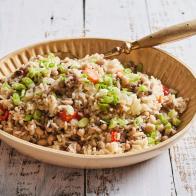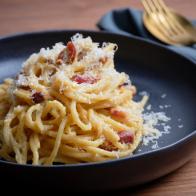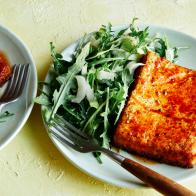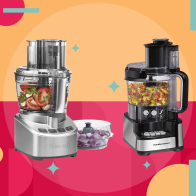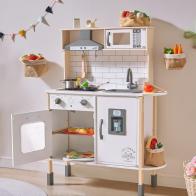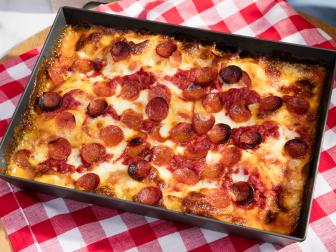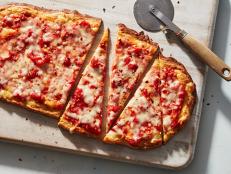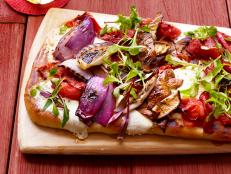I’m a Dietitian and I Eat Pizza Every Week – Here’s How I Keep It on the Healthier Side
It’s all about quantity and customization.

Westend61/Getty Images
Fridays are for pizza – and maybe even for the other six days of the week, too. For the last 15 years I have been making pizza (almost) every week for my family and they have yet to grow tired of it – really. Love for pizza making has roots in my childhood and my methods continue to evolve. But pizza, in one form or another is a constant. Neighbors, friends and fellow dietitians ask many questions. Is pizza healthy? Do I make my own ingredients? How do I cook my pizza? Do I ever just order pizza? The answers to these and more in my ode to homemade pizza.

Boston Globe/Getty Images
Why I Love Pizza
Two words: New. Haven. I grew up in the mecha of pizza. Between trips to Wooster Street (if you know, you know) and the local pizzeria down the street from my childhood home, it was always part of my life. New Haven-style pizza is just special – thin, charred crust, a thin layer of tangy sauce and just the right amount of salty cheese. Pizza is such a fixture in Connecticut culture, a bill was proposed in February 2023 to crown pizza Connecticut’s official state food.
My dad worked hard to perfect his homemade pies and without even noticing, I found myself doing the same when I had kids. Pizza makes for an easy weeknight dinner. All of the components can be made (even frozen) ahead, assembly is simple and cook time is minimal. It’s easy to modify and can easily feed a crowd. I spent years contently making pizza on various types of pans in my home oven (more on equipment below). Occasionally, I’d venture outside and throw a pizza on the grill. We took things to the next level, and began wood firing in 2020. Building a wood fired oven in your backyard is a costly undertaking but I don’t regret one cent. We hired a mason who assembled a pre-casted dome and built a brick floor underneath (the cooking surface). Learning to cook pizza at 800+ degrees Fahrenheit, instead of 500 degrees, does take some adjusting, but to date, I have only totally incinerated one pie. The art of pizza making has gone viral and there are now several options for both wood and gas fired ovens perfect for even smaller backyard set-ups.
32 Pizza Recipes Everyone Will Devour 32 Photos
Whether you prefer classic cheese or a new-school spin, we’ve got you covered with these homemade pies.
How Pizza Can Be Healthy
Dough, sauce, cheese, toppings. There is nothing inherently unhealthy about pizza ingredients (carb haters can kindly step aside). Homemade pizza allows you to control the quality, but more importantly, the quantity of the ingredients. Pizza is also the ultimate opportunity to reduce food waste – dig through the fridge on a Friday, and your fixings choose themselves.
Dough: Whole grain flours can be incorporated into dough, but I prefer a mix of 50/50 white all-purpose flour and 00 flour. Gluten Free Pizza Flour from King Arthur is excellent and frozen premade crusts from Banza are a go-to for last-minute pizza making. Both should be placed in a cast-iron skillet for preparations above 500 degrees Fahrenheit.
Cheese: Mozzarella cheese is high in protein. Part-skim cheeses work well at and below 500 degrees. Use a whole milk cheese for anything hotter. A light sprinkle of cheese is all that is required; aged Parmesan and sharp Provolone add big flavor, so you can use less. For those with lactose issues, make your pizza with low- or no-lactose cheeses like Parmesan, cheddar, goat or Swiss.
Toppings: Pile the vegetable toppings high, or serve along with a salad, and your pizza meal is incredibly balanced. Lean meats like chicken and ground turkey are welcomed additions. Toppings can also be placed atop a cooked pizza – that is the best time to pile on fresh herbs, a drizzle of hot honey or some lightly dressed greens.
Tools That Make Pizza Making At Home Easy
I realize not everyone has the inclination or the desire to build a massive pizza oven. Instead, here are some must-have pieces of equipment – big and small – that can help make pizza at home happen, whether you’re cooking it indoors or out.
My go-to indoor pizza pans. Can be used for thin or thick crusts and a great way to feed a crowd.
My cooking surface of choice for a crispier crust. Cook the pizza directly on this stone – preheat it in the oven while you assemble your pizza.
A less heavy alternative to a pizza stone, a pan with holes allows air to circulate for a crispier crust. This is also great for reheating leftovers.
A must-have for outdoor ovens and pizza stones, peels come in all shapes and sizes. Roll out your dough on a separate surface, sprinkle some cornmeal on the peel. Place the rolled-out dough on the peel, add your sauce, cheese and toppings and slide into the oven or pizza stone.
It’s good form for pizza makers to keep a clean and sharp pizza wheel accessible at all times. If you find yourself without one, use a pair of kitchen shears.
Grilled pizzas are a fabulous summer meal – place rolled out dough directly on the grill and allow to cook for one to two minutes. Flip over, add your toppings and cook for a few minutes more. Propane grills work nicely and if you want to impart additional flavor, cook on a charcoal grill. For some smoky goodness, try a wood pellet like Traeger where you can easily control the temperature and the amount of smoke.
I tried Solo Stove’s oven and was shocked by how good the pizza came out. It can be fueled with wood or propane, and heats up quickly.
… And yes, sometimes we just order pizza.
Related Content:
